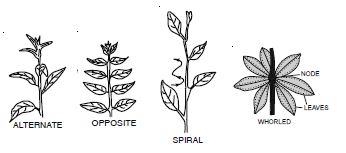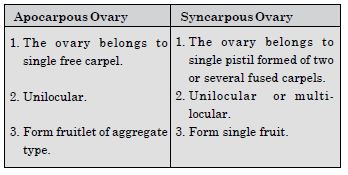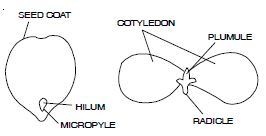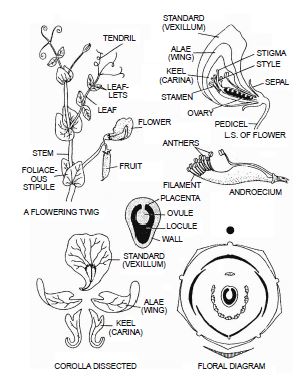The top educational resources, NCERT Solutions at Aasoka are available for Class 11 students to ace their exam preparation. These are prepared thoroughly by subject matter experts who ensure the quality of the content. The latest CBSE syllabus is followed while designing NCERT Solutions for Class 11. The experts cover the entire concept accurately so as not to miss out on anything important. Give a boost to your overall performance with NCERT Solutions.
In the chapter “Morphology of Flowering Plants” of Class 11 Biology, students will learn about the morphology of various parts of flowering plants including leaf, stem, root, flower, inflorescence, seed; semi-technical description of a flowering plant, description of family Solanaceae, etc.
Question 1:
What is meant by modification of root ? What type of modification of root is found in :
(a) Banyan tree (b) Turnip (c) Mangrove trees.
Answer:
Modification of root
Roots in some plants change their shape and structure and become modified to perform functions other than absorption and conduction of water and minerals. They are modified for storage of food, support and respiration.
(a) Banyan tree has Prop roots. These adventitious aerial roots arise from horizontal aerial branches of the trees like Ficus bengalensis (Banyan). Initially, they are hygroscopic in function, become red in moist condition and possess root-caps at their apices. They grow vertically downward, penetrate the soil, become thick and assume the shapes of pillars. They provide support to the spreading branches of tree. Sometimes the main trunk dies and it is replaced by prop roots which assume the shapes of trunks.
(b) Turnip has Napiform roots. These type of roots are thickest at the base and take spherical shape. Towards lower side, they suddenly thin out. In turnip food is stored in swollen part.
(c) Mangrove trees have pneumato-phores as roots. These roots develop in marshy places where there is an inadequate oxygen supply in water logged soil. So these roots come above the soil to absorb air.
Question 2:
Justify the following statements on the basis of external features :
- Underground parts of a plant are not always roots.
- Flower is a modified shoot.
Answer:
- It is obvious that roots normally grow below the ground while the stem grows above the ground. In some case the stem grows below the ground and serves as organ of perennation, vegetative propagation and storage of food. The potato tubers are solid, thickened modified underground stems meant for storage of food mainly starch and vegetative propagation. The tubers have axillary buds at the nodes often called as ‘eyes’. Thus the presence of buds proves that it is a stem and not a root although it is underground. The presence of nodes and internodes and moreover its internal structure confirms its stem nature.
- Flower is modified shoot. It consists of highly reduced stem branch to form thalamus in which nodes are borne only towards the tip. It bears sexual organs and meant essentially for sexual reproduction of plants. Its outer whorls of sepals and petals represent the leaves. The androecium and gynoecium represents buds.
Question 3:
How is pinnately compound leaf different from a palmately compound leaf ?
Answer:
Question 4:
Explain with suitable examples the different types of phyllotaxy.
Answer:
Phyllotaxy. The arrangement of leaves on the stem is termed phyllotaxy. This arrangement enables sunlight to reach every leaf of the plant. It is of following types :
(1) Alternate. A single leaf arises at each node in alternate manner e.g. China rose, Mango and Hibiscus.
Phyllotaxy or arrangement of leaves on stem
(2) Opposite. A pair of leaves arise at each node and lie opposite to each other e.g. Guava, Calotropis and Mint, Zinnia and Salvia. It may be further divided into opposite decussate and opposite super-posed. Opposite decussate in Calotropis and opposite superposed in jamun.
Question 5:
Define the flowing terms :
- aestivation
- placentation
- actinomorphic
- zygomorphic
- superior ovary
- perigynous flower
- epipetalous stamen.
Answer:
- Aestivation. The mode of arrangement of petals in floral bud with respect to other members of the same whorl is known as aestivation.
- Placentation. The arrangement of ovules within the ovary is called placentation. It may be marginal, axile, parietal, basal, free central or superficial.
- Actinomorphic. When a flower can be divided longitudinally into two symmetrical halves in more than one plane, it is called actinomorphic.
- Zygomorphic. When a flower can be divided into two equal similar halves only in one particular vertical plane, it is zygomorphic e.g. pea.
- Superior ovary. When the gynoecium occupies the highest position while all others are situated below it, such condition of the ovary is called superior ovary e.g. mustard.
- Perigynous flower. If gynoecuim is situated in the centre and other parts of the flower are located on the rim of the thalamus almost at the same level, it is called perigynous. e.g. plum.
- Epipetalous stamen. When stamens are attached to the petals as in brinjal, they are called epipetalous stamen.
Question 6:
Differentiate between :
- Racemose and cymose inflorescence
- Fibrous root and adventitious root
- Apocarpous and syncarpous ovary.
Answer:
- Differences between Racemose and cymose inflorescence
- Differences between fibrous root and adventitious root
- Differences between Apocarpous Ovary and Syncarpous Ovary
Question 7:
Draw the labelled diagram of Gram seed
Answer:
Gram seed
Question 8:
Take one flower each of the families Fabaceae and Solanaceae and write its semi-technical description. Also draw their floral diagram after studying them.
Answer:
Family Fabaceae e.g. Lathyrus odoratus (Sweet pea) (Fig. 5.5)
Habit. An annual, cultivated, ornamental, climbing herb.
Root. Tap-root, branched with root nodules.
Stem. Herbaceous, aerial, weak, branched, winged, hollow, glabrous, green, climbing.
Leaf. Ramal and cauline, alternate, petiolate, compound imparipinnate, upper leaflets modified into tendrils, stipulate, stipules leafy, paired, appressed to stem, hastate, entire acute.
Inflorescence. Racemose or solitary axillary.
Flower. Pedicellate, bracteate, complete, hermaphrodite (bisexual), zygomorphic, cyclic, slightly perigynous, pentamerous, variously coloured.
Calyx. Sepals 5, gamosepalous, valvate aestivation, green, hairy, persistent.
Corolla. Petals 5, polypetalous, vexillary aestivation, papilionaceous consisting of larger posterior petal, the vexillum, two lateral wings (alae) and two inner petals fused to form the keel (carina).
Androecium. Stamens 10, diadelphous, nine fused in the form of a tube around the ovary and tenth, posterior one free, anthers dithecous, basifixed, introrse.
Floral description of Lathyrus odoratus Gynoecium. Monocarpellary, unilocular, ovary half-inferior, marginal placentation, style long and curved, stigma capitate, covered by the keel.
Fruit. Legume.
Floral formula.
Family Solanaceae
Solanum nigrum
(Indian night shade, Vern. Makoi) (Fig. 5.6)
Habit. An annual wild herb.
Stem. Herbaceous, aerial, erect branched, cylindrical, solid, slightly ridged, green, smooth.
Leaf. Ramal and cauline, alternate (opposite in floral region), petiolate, simple, exstipulate, shape ovate, margin entire, acute apex, unicostate reticulate venation, glabrous or sparsely hairy.
Inflorescence. Cymose, extra-axillary cyme (rhipidium).
Flower. Ebracteate, pedicellate, Actinomorphic, hermaphrodite, pentamerous except gynacium, complete, regular, hypogynous.
Calyx. Sepals 5, gamosepalous, valvate aestivation, odd sepal posterior, persistent, green.
Corolla. Petals 5, gamopetalous, campanulate, valvate aestivation, alternative with sepals, rotate, white.
Androecium. Stamens 5, polyandrous, epipetalous, alternative with petals, filaments short and hairy, anthers bithecous, basifixed, long, yellow, dehisce by terminal pores.
Gynoecium. Bicarpellary, syncarpous, bilocular, many ovules in each locule, ovary superior, obliquely placed, axile placentation, septum is oblique and placenta swollen, style long, stigma bifid, green and capitate.
Solanum nigrum A ; a flowering branch; B. V.S. flower; C. floral diagram
Fruit. Berry.
Floral formula.
Question 9:
What is a flower ? Describe the parts of a typical angiospermic flower.
Answer:
Flower (Fig. 5.4). The flower is the reproductive unit in the angiosperms. It is meant for sexual reproduction. A typical flower has four different kinds of whorls arranged successively on the swollen end of the stalk or pedicel, called thalamus or receptacle. These are calyx, corolla, androecium and gynoecium.
Parts of a Flower
- Calyx. The calyx is the outermost non-essential whorl of the flower and the members are called sepals.
- Corolla. Corolla is non-essential whorl composed of petals. Petals are usually brightly coloured to attract insects for pollination.
- Androecium. Androecium is essential whorl composed of stamens. Each stamen which represents the male reproductive organ consists of a stalk or a filament and an anther. The pollen grains are produced in pollen sacs of anther.
- Gynoecium. Gynoecium is essential whorl, the female reproductive part of the flower and is made up of one or more carpels. A carpel consists of three parts namely stigma, style and ovary. Ovary is the enlarged basal part, with an elongated tube, the style. The style connects the ovary to the stigma. The stigma is usually at the tip of the style and is the receptive surface for pollen grains. Each ovary bears one or more ovules attached to a flattened, cushion-like placenta.
Question 10:
How do leaf modifications help plants ?
Answer:
Modifications of leaf. The leaves or their parts may be modified to perform certain special functions other than synthesis of food. The modifications are as follows :
1. Leaf tendrils. Thread-like structures capable of coiling.
- Whole leaf in wild pea
- Leaflet tendril in Pisum
- Petiolar tendril in Nepenthes
- Leaf tip in Glory lily
- Rachis tendril in Clematis
- Terminal leaflet in Narvelia
2. Spines. They give protection, various leaf parts modified into spines are
- Stipules in Acacia, Zizyphus
- Leaf margins in Argemone,
- Leaf apex in Phoenix, Yucca
- Whole leaf in Berberis.
3. Leaf roots. A leaf transforms into roots for balancing on water, e.g., Salvinia.
4. Phyllode. Petioles modify into a leafy structure, e.g., Acacia, Parkinsonia.
5. Pitchers. Leaf lamina modifies to form a large pitcher e.g., Nepenthes (insectivorous), Dischidia (non-insectivorous).
6. Leaf bladder. Leaf modifies into bladders which trap insects and then close by a valve present on the tip of bladder, e.g., Utricularia.
7. Hooks. They help the plants in climbing, e.g., Bignonia, Asparagus.
8. Tentacles. Leaves form tentacles for eating prey e.g. Drosera.
9. Scale or protective leaves. They protect the vegetative buds by covering them e.g, Ficus, Artocarpus.
Question 11:
Define the term inflorescence. Explain the basis for the different types of inflorescence in flowering plants.
Answer:
The arrangement of flowers on the floral axis is termed as inflorescence. Depending on whether the apex gets converted into a flower or continues to grow, two major types of inflorescences are defined—racemose and cymose.
Question 12:
Write the floral formula of a actinomorphic, bisexual, hypogynous flower with five united sepals, five free petals, five free stamens and two united carpels with superior ovary and axile placentation.
Answer:
Question 13:
Describe the arrangement of floral members in relation to their position on thalamus.
Answer:
Differences between hypogyny, perigyny and epigyny












